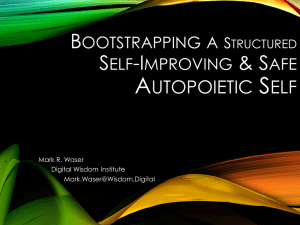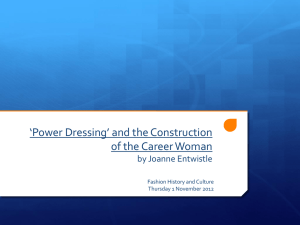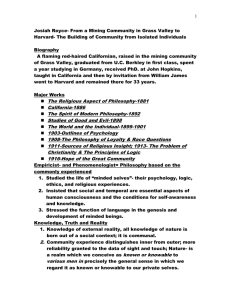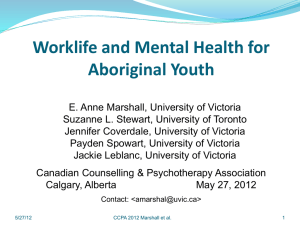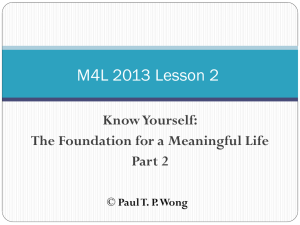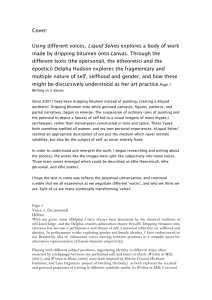Metabolic Syndrome
advertisement
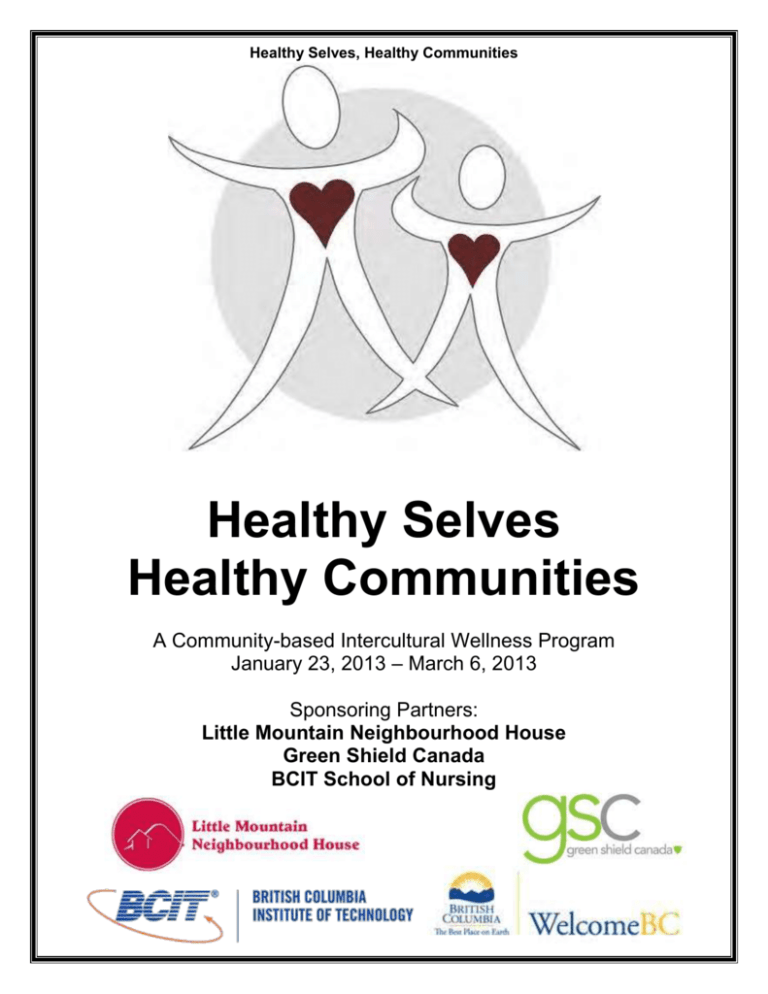
Healthy Selves, Healthy Communities Healthy Selves Healthy Communities A Community-based Intercultural Wellness Program January 23, 2013 – March 6, 2013 Sponsoring Partners: Little Mountain Neighbourhood House Green Shield Canada BCIT School of Nursing 1 Healthy Selves, Healthy Communities “BC communities continually create, improve and integrate social, cultural, environmental and economic assets that support health, well-being and the capacity to realize their fullest potential‖ (BC Ministry of Health, 2007). About the Healthy Selves, Healthy Communities program Little Mountain Neighbourhood House (LMNH) is a hub for health literacy and community wellness. The promotion of healthier lives ultimately leads to healthier communities. Healthy Selves, Healthy Communities is a twelve week health and wellness program organized in partnership between Little Mountain Neighbourhood House (LMNH) and the British Columbia Institute of Technology (BCIT) School of Nursing; with funding provided by Green Shield Canada (Community Giving Program), and Welcome BC‘s Building Welcoming and Inclusive Neighbourhoods program. The program is designed to increase community capacity, health literacy, knowledge of intercultural approaches to health and wellness, and promotion of healthier lifestyles to reduce risks of chronic illness. BCIT Practicum students Brandi Dan and Cheryl Bejar worked closely with LMNH‘s Building Welcoming and Inclusive Communities Coordinator, Jennifer Wesman, to coordinate and facilitate the weekly sessions. The outcome of this project was an intercultural learning experience and document designed to share valuable health information and community resources. The information found in this document condenses the 6-week curriculum, activities, and discussions that were fundamental for increasing health and wellness in the participants—and in our greater community. If you would like more information, or to register for future Healthy Selves, Healthy Communities programs, please contact Jennifer at Little Mountain Neighbourhood House at 604-879-7104 (ext 315) or email: Jennifer_wesman@lmnhs.bc.ca 2 Healthy Selves, Healthy Communities Table of Contents Page Topic 4 Photos 5/6 Testimonials from the Facilitators 7 What is health? 9 Brain Function and Memory 19 Stress and Healthy Coping 26 Meditation for beginners 29 Arthritis 37 Metabolic Syndrome 45 Understanding Cancer 50 Healthy Changes Action Plan 51 Resource links 52 Glossary terms 3 Healthy Selves, Healthy Communities 4 Healthy Selves, Healthy Communities Testimonials “Community is defined as a group of people with a common interest or a common goal and I believe that Healthy Selves-Healthy Community was a ”community”. We were brought together to share a common goal and that was to share knowledge, to promote and encourage healthy lifestyles. Working with the Healthy Selves-Healthy Community program was by far one of the best experiences I have had in the BCIT Nursing Program. This would not have been possible without all the active participants and wonderful support staff. I would like to thank all those participants who came weekly to listen to our health presentation, asked questions, gave insightful analogies and shared their own personal experiences with us. Community nursing is by being active participants you challenged me as a nursing educator and motivated me to give you relevant and reputable information. This session would not have been as successful without all of you. From this experience, I am walking away with many new skills and ideas that will be invaluable as I prepare to start my own career as a nurse. I am especially grateful for having had the opportunity to sharpen my communication skills by working with community members firsthand and working in such a positive environment. Thank you all and best of luck!” - Brandi BCIT Student Nurse “The greatest wealth is health”-Virgil 5 Healthy Selves, Healthy Communities “My experience working with the Healthy Selves Healthy Communities has been so wonderful and inspiring. As a BCIT Student Nurse, I came to this public health placement as a facilitator to share the knowledge and skills I had gained through my own education. However, I didn’t realize how much I would learn from this experience – from the program, from Jennifer and the volunteers, and mostly, from the participants. The Healthy Selves Healthy Communities group is very special. The group is made of such diverse individuals, from various backgrounds, ages, and cultures. However, despite their differences, they are able to form a cohesive unit through their shared interest in learning about health. The participants always brought a positive energy and enthusiasm for learning with them to each class. I felt the sense of pride that the participants had in the program. The participants took ownership of the program and their own learning; they decided which topics were of interest and relevant to them and, often, initiated thoughtful discussion during sessions with their many questions. It was wonderful to see many of the participants share their experiences, knowledge and skills with the rest of the group. In such a short time, I was able to witness the positive impact this program has had on the participants. My experience with the Healthy Selves Healthy Communities program has also been very meaningful. Facilitating health topics to the group strengthened and solidified my knowledge, particularly in anatomy and pathophysiology. Through this program, I was also able to make connections and become aware of various health resources and references available within the community, which will definitely benefit me in my future nursing practice. I am honoured to have been a part of the Health Selves Healthy Communities program and witness to community development in action! Health and happiness to everyone!” - Cheryl, BCIT Student Nurse 6 Healthy Selves, Healthy Communities What is Health? A state of complete physical, mental and social wellbeing. The absence of illness and disease. Healthy body, healthy mind. Dimensions of Health: Physical, Mental and Social. Physical Health: The state of the physical body. o Being free of pain, disease or sickness o Having energy to do physical activities o Good movement and balance o Good vision and hearing Mental Health: A person’s state of mind and feelings. o Communicating well with others o Positive self-esteem (Feeling good about yourself) o Being able to cope with stress o Being aware of feelings and expressing them o Feeling a sense of belonging Social Health: How we act and behave. o Communicating well with others o Being independent and cooperative with others o Showing respect o Develop positive relationships o Being a part of a community 7 Healthy Selves, Healthy Communities Optimal Health is a balance between each dimension of health. Physical Optimal Health Mental Social A Continuum of health suggests that there is no such thing as ‘perfect health’ but each individual does have the opportunity to achieve optimal health if they desire. (Matthews & Stone, 2009, p9). Where would you place your state of health on this continuum right now? Consider why have you placed yourself as in a state of optimal, good, average or poor health? 8 Healthy Selves, Healthy Communities Brain Function and Memory The Brain: The brain has the size and appearance of a small cauliflower. But thanks to its 100 billion nerve cells (as many as there are stars in our galaxy!), we can think, plan, talk, imagine, and so much more. The brain accounts for only about 2% of the total weight of the human body, but constantly accounts for about 20% of its blood and oxygen use. Brain Anatomy: Two cerebral hemispheres: Each takes care of one side of the body, but the controls are crossed: the right hemisphere takes care of the left side, and vice versa. If each hemisphere were unfolded, it would be the size of an extralarge pizza! For this reason, the brain must fold over on itself many times to fit into the skull. Four major external lobes: Frontal Parietal Temporal Occipital 9 Healthy Selves, Healthy Communities Frontal Parietal - Command and control centre in body - Involved in processing pain and touch - Functions: reasoning, problem solving, judgement, impulse control, higher emotions (empathy & altruism), motor control and memory. - Functions: sensation (taste, touch, temperature and pain), cognition, movement, orientation, recognition and speech. Temporal Occipital - Involved in auditory (sound) sensation and where Primary Auditory Cortex located - Controls visual sensation and processing - Functions: language recognition, distinguish volume and frequency of sound, forming and recalling memories - Functions: analyse form, colour and movement; recognize and identify objects. The Limbic System: is the fifth lobe located in the centre of the brain. This area is involved in emotional experience and in the control of emotion-related behaviour. Stimulation of specific areas in this system can lead to feelings of dread, high anxiety, or exquisite pleasure. 10 Healthy Selves, Healthy Communities The Nervous System: The brain is something like the body’s control tower. It must be kept quickly informed of the body’s needs and of the resources available in the environment to satisfy them. For this purpose, the brain relies on a vast network of “wiring” distributed throughout the body: the nerves. Together with the brain and the spinal cord, the nerves constitute the nervous system. The Central and Peripheral Nervous System: Central Nervous System Peripheral Nervous System The central nervous system consists of the brain and its natural extension, the spinal cord, which runs through the centre of the spinal column. The spinal column, together with the skull, provides a veritable suit of armour for the precious central nervous system. The peripheral nervous system consists of the nerves, some of which gather information while others transmit orders. The facial nerves enter and leave the brain directly through the skull. Other nerves reach the brain via the spinal cord. Neurons: Specialized cells in the nervous system that are responsible for communicating messages to and from the brain and other parts of the body. 11 Healthy Selves, Healthy Communities Neural Communication: All of our sensations, movements, thoughts, and emotions are the result of communication between neurons. This communication is carried out by two complementary processes: electrical conduction and chemical transmission. Synapses: The point where two neurons connect and pass nerve impulses. o Electrical Synapses: The neurons touch and nerve impulses pass directly. o Chemical Synapses: The neurons do not touch and nerve impulses are passed from neuron to neuron with the help of chemical neurotransmitters. Neurotransmitters: Chemical molecules that “ferry” nerve impulses across the synapse from one neuron to the next. The majority of synapses in the human brain are chemical synapses. Chemical synapses are slower than electrical ones but are also far more flexible, which is the foundation of all learning. 12 Healthy Selves, Healthy Communities What affects Brain Function Aging: Brain weight and volume decrease as you age. The brain loses 5-10% of its weight between the ages of 20 and 90, resulting in decreased brain functioning. Alzheimer's is associated with aging and related to the inflammatory process. This process occurs within all aging adults creating plaques found mostly in hippocampus (an area of the brain related to forming new memory). Age-related decrease in dopamine (pleasure and reward hormone) results in slowed metabolism in the area of the brain responsible for cognition. Men lose more grey matter as they age. Women lose more white matter. Physical Inactivity: Low physical activity decreased blood flow to the brain. People who exercised at least 3X a week at medium intensity ( more vigorous than walking) showed 50% less cognitive impairment, and 60%) less Alzheimer’s diagnosis. Physical activity also lowers blood glucose levels. (High blood glucose levels are associated with reduced brain function). 13 Healthy Selves, Healthy Communities Gender: Overall brain volume is greater in men than women. Women are more likely suffer cognitive impairment due to longer life span. Lifestyle Factors: o Diet: Neuorgenesis is the process by which the brain makes new cells. A diet high in sugar and saturated fat diminishes neurogenesis o Drinking: Small quantities of alcohol increase neurogenesis, large amounts decrease it. o Substance Abuse: Nicotine, caffeine, heroin, antidepressants, and sedatives affect how quickly and often neurotransmitters fire. Stimulation or inhibition should only be temporary, but prolonged exposure causes damage and decreased transmission. o Stress: cortisol is released from the brain during stressful situations initiating the fight or flight response. Continuous release of this stress hormone affects the hippocampus, the part of the limbic brain which is central to learning and memory. Too much cortisol can prevent the brain from keeping a memory or recalling an old one. Men react with "fight-or-flight" response (cortisol release). Women react with "tendand-befriend" response. o Education: Those with fewer years of education are at greater risk of having dementia and a greater risk of developing dementia. It is believed that higher educated people have a “cognitive reserve” that allows them to manage longer during cognitive decline. 14 Healthy Selves, Healthy Communities Memory and Learning Memory is essential to all learning because it lets you store and retrieve the information that you learn. Memory is basically nothing more than the record left by a learning process. Thus, memory depends on learning. But learning also depends on memory, because the knowledge stored in your memory provides the framework to which you link new knowledge, by association. And the more extensive your framework of existing knowledge, the more easily you can link new knowledge to it. Short-Term Memory: This ability to hold on to a piece of information temporarily in order to complete a task is specifically human. It causes certain regions of the brain to become very active, in particular the pre-frontal lobe. Long-Term Memory: Information is transferred from short-term memory (also known as working memory) to long-term memory through the hippocampus. The hippocampus is a bit like a sorting centre where these new sensations are compared with previously recorded ones. The hippocampus also creates associations among an object’s various properties. 15 Healthy Selves, Healthy Communities When we remember new facts by repeating them or by employing various mnemonic devices, we are actually passing them through the hippocampus several times. How Learning Alters the Mind Every time you learn something, neural circuits are altered in your brain. These circuits are composed of a number of neurons (nerve cells) that communicate with one another through special junctions called synapses. When you learn something, it is actually these synapses whose efficiency increases, thus facilitating the passage of nerve impulses along a particular circuit. Plasticity: The ability of the neurons to modify their connections to make certain neural circuits more efficient. Plasticity is the fundamental characteristic of the human brain that makes learning and memory possible! Use It or Lose It! Forgetting is a natural phenomenon. It is even essential. In fact, the reason we forget is that our brains are organized to eliminate anything that might clutter them up needlessly. We forget mainly those things that were not encoded firmly enough in our networks of nerve cells. 16 Healthy Selves, Healthy Communities Ways to Improve Your Memory: Adopt a healthy lifestyle, and in particular get enough sleep: You cannot learn new things while you are sleeping but you can effectively retain the things you learned during the day if you get a full night’s sleep afterward. Eat Healthy: Eat 5 small meals a day. Maintain consistent level of blood glucose. High insulin levels have shown to impair thinking and decrease ability to form memories. Eat foods rich in: Omega-3 fats (Fish, vegetable oils, pecans, walnuts, and hazelnuts). High fibre carbohydrates (whole grain breads, brown rice, popcorn, and whole oats). High in antioxidants (blueberries, cranberries, beans) Flavonoids found in black tea, red wine and dark chocolate Do things that exercise your memory: For example, reading is an excellent way of exercising your memory, because it makes you continuously apply your attention and your visual perception, 17 Healthy Selves, Healthy Communities construct mental images, organize information, and do other things that are all essential for a good memory. Organize your mind: Two strategies for organizing information in your mind are repetition and elaboration. o Repetition: Take the piece of information that you are trying to memorize, and you repeat it continuously, to try to keep it in your short-term memory, as long as possible. o Elaboration: Associate the new piece of information with other information that you have already recorded in your long-term memory. Ideas for Brain Exercises: Daily cross-word puzzles Play chess Play Sudoku Read books or newspapers daily Use non-dominant hand for daily activities (Increase neural connections) 18 Healthy Selves, Healthy Communities Stress and Healthy Coping What is stress? Stress occurs from everyday life activities which create a physiological and mental reaction. Stressors in Everyday life: Environment- hot, cold, traffic, noise, interruptions (family), phones ringing, moving homes Physiological- hungry, tired, sick, fear, drug withdrawal Socio-cultural- financial, relationship problems, death, Cognitive- thoughts, feelings, attitudes, own personal beliefs How does stress affect me? Stress Response has three stages: Stage 1: Generate Energy-adrenaline release, heart beating, breathe quicker. Stage 2: Use stored energy-if there is no solution or change from stage 1 the body release stored sugar and fats-mental pressure, driven to complete task, tired, anxious, difficulty remembering and may become sick with cold/flu. This is the stage most people begin pleasure seeking behaviours (ie. substance use) 19 Healthy Selves, Healthy Communities Stage 3: Draining Energy Stores-chronic stress affects the body’s ability to provide energy for itself-insomnia, errors in judgment, and personality changes including angry outbursts. This is the stage that most people develop illness including heart disease and mental illness. 20 Healthy Selves, Healthy Communities Coping: There is no one specific way to deal with stress. We all have different likes and dislikes and ways to relax. It is important to determine how and when you need to take time out to de-stress. It is helpful to look at short term and long term solutions to stress. Negative Coping The Pleasure Centres of the Brain: For a species to survive, its members must carry out such vital functions as eating, reproducing, and responding to aggression. Certain areas in our brain are responsible for providing a pleasurable sensation as a “reward” for carrying out these vital functions. These areas are connected with one another to form the pleasure or reward circuit. When we experience something positive or pleasurable, certain neurons communicate with other parts of the brain part of the brain to encourage us to repeat these experiences again in the future. Dopamine, a chemical messenger (aka neurotransmitter), is used to pass these messages between the neurons in the brain. An increase in the level of dopamine in the brain reinforces the behaviours that satisfy our fundamental needs. 21 Healthy Selves, Healthy Communities Substance Use: There are many reasons that people take substances that alter their mental state. Examples of substance use: Alcohol Coffee Smoking Ecstasy In all these cases, taking the drug provides an immediate sense of pleasure or relief that encourages the person to take it again. Drug-taking is an artificial means of activating this natural pleasure centres in the brain. The Pleasure Centres Affected by Drugs The brain regions involved in the sensation of pleasure and reward are among those most affected by drugs. The areas of the brain, such as the limbic system and nucleus accumbens that are involved in controlling emotions and motivations are most affected by drugs. The frequent consumption of a drug is known to also tremendously increase the amount of the main neurotransmitter in this part of the brain, dopamine. 22 Healthy Selves, Healthy Communities Therefore, the effect on our emotions, motivation and pleasure centres of the brain can help us understand the addictive nature of and dependency on certain drugs. In these images of the brain, the red areas indicate large numbers of dopamine receptors. These images show that people who are alcoholic, obese, or cocaine-dependent have fewer dopamine receptors than normal people do. Dependency and Pleasure Dependencies have a very close relationship with pleasure. Psychoactive substances (i.e. tobacco and alcohol) have an effect on neurons in the brain that form what is called the pleasure or reward circuit. Normal Normally, this system is activated by natural signals, such as satisfaction of needs (i.e. hunger thirst, sex, friendship, etc.). Dependency However, psychoactive substances short circuit this system by activating the pleasure circuits directly. All psychoactive substances generate a positive reinforcement that motivates the person to repeat the pleasant experiences. This can lead to a dependency. 23 Healthy Selves, Healthy Communities How Drugs Affect the Brain Human behaviours and emotions are controlled by neurotransmitters that act as keys between neurons (think: of the “ferry” passing the nerve impulses between the neurons!). Drugs act on the brain by imitating, stimulating, or blocking the effects of certain neurotransmitters. The reward/pleasure circuit in the brain is the one most affected by drugs. This reward circuit that is over stimulated by drugs uses the neurotransmitter, dopamine. Most of the drugs that cause dependencies increase the amount of dopamine in the reward circuit. Positive Coping Identify your problems. Decide what your stressors are…finances, relationship, and employment. Write them down. Brain storm solutions your problems. What can I do to change this problem? Develop budget, talk to you partner about what is bothering you? Change jobs? Decide if you have to deal with this problem now…if you don’t what is the outcome? Talk about your problems. Try not to bottle up your feelings? Share with family and friends and if you would rather talk to someone else seek out your family doctor, a counsellor or counselling group. 24 Healthy Selves, Healthy Communities Develop stress management techniques. There are many stress management technique available. Determine what works for you and practice this periodically throughout your week. Maintain you Health (Eat, Sleep, Exercise) Eating a healthy diet overall will help your body to function at its optimum. The brain needs nutrients to develop and the body needs nutrients to produce energy to deal with everyday stressors. Remember to get enough sleep to allow brain to regenerate and replenish. Exercise is a release of tension for the body and aids in reducing stress. Prevent future stress. Make decision now. Avoid putting things off. Delegate tasks to others to relive your burden. Do something that makes you happy and takes your mind off your problems even for a short time!!!!! 25 Healthy Selves, Healthy Communities Meditation Techniques for Beginners: Guided Healing & Law of Attraction Meditation for Relaxation, Visualization, Stress, Sleep + more What is Meditation? Meditation is a tool for the re-discovery of the body's own inner intelligence. Practiced for thousands of years, it's not about forcing the mind to be quiet, it's finding the silence that's already there and making it a part of your life. From this field of pure potentiality we get our bursts of inspiration, our most intuitive thoughts, and our deepest sense of connection to the universe. Benefits of Meditation As many studies show, a regular meditation practice offers numerous health benefits, including lowering blood pressure, strengthening the immune system, and releasing stress and fatigue. In fact, meditating for half an hour provides more psychological rest than a full night's sleep. Simple Healing Meditation: 1. First of all, the most important thing is sit comfortably with your back straight. Keep your hands open, and be comfortable. 2. Repeat to yourself loudly the two words, 'I am. I am. I am. I am.' 3. Now you can close your eyes and whisper those two words to yourself, 'I am. I am. I am.' 26 Healthy Selves, Healthy Communities 4. Now stop whispering those two words and keep repeating them mentally, with your eyes closed. Make sure that your lips and your tongue doesn't move and just keep repeating them. You may have other thoughts. You might feel sensations in your body. You might hear sounds in your environment. Whenever you become conscious of that then go back to repeating 'I am', mentally, without moving your lips and your tongue. Do this for about five to ten minutes. Preferably ten, but five is good enough. 5. Keep your eyes closed, and bring your awareness into your heart, right in the middle of the chest. With all of your awareness try to see, sense, feel your heartbeat. See if you can sense your heartbeat either as a sound or a sensation. 6. Bring your awareness to your fingertips, to your hands. Feel your heartbeat in your fingertips. You feel that? You've just diverted blood flow to your hands. This is one of the fastest ways to relieve a migraine headache. 7. Now bring your awareness back into your heart and just mentally repeat the four words that I'm going to ask you to repeat, mentally. Peace. Harmony. Laughter. Love. Peace. Harmony. Laughter. Love. Do that for two minutes and now move your awareness anywhere in your body that you want to bring healing to. You don't have to visualize anything, you don't have to say anything, just bring your awareness. Just bringing awareness to these different parts of your body will bring consciousness, which is healing. 27 Healthy Selves, Healthy Communities 8. Finally, come back to your heart, and in one minute or so say again those four words: Peace. Harmony. Laughter. Love. Remember those are the goals of all the other goals in our life, whatever we want, ultimately that's what we want. So repeat: Peace. Harmony. Laughter. Love. 9. Now keep your awareness in your heart and just for one minute, experience gratitude. You experience gratitude by thinking of all the things you're already grateful for. The more you experience gratitude, the more you'll attract things in your life that will make you feel even more grateful. Do that for a second, a few seconds, relax into your body, and open your eyes. This is a healing meditation. 28 Healthy Selves, Healthy Communities Arthritis: Healthy Joints, Healthy Movement Define Arthritis: “arthro” meaning joint, and “itis” meaning inflammation. Statistics: 4.6 million Canadians <15 years report arthritis this will increase to 7 million by 2031 Anyone can get arthritis regardless of age, physical condition or ethnic background. 2/3 of those affected are women Highest cause of disability in Canada in both men and women Types of Arthritis: Over a 100 types most prevalent are Rheumatoid (RA) and Osteoarthritis (OA). RA- immune-mediated systemic inflammatory joint diseases. OA-degenerative joint disease usually preceded by previous joint injury or other factors. Responsible for 80% of hip replacement surgery and 90% of knee replacements in Canada. 29 Healthy Selves, Healthy Communities Basic pathophysiology RA- is considered an autoimmune disease that causes an increase in white blood cells (WBC) to the area surrounding the joint. This movement of cells results in inflammation to the joint, pain and difficulty moving. WBC causes other fluid-like substances to increase and this causes edema. Mast cells and fibroblast cells release histamine and enzymes that cause destruction of the cartilage. Cytokines are released and cause increased inflammation in the synovial layer. The synovial layer becomes thick and full and pushes into the joint cavity and causing friction on the joint during movement. OA-is considered a degenerative disease in which it is observed there is a steady decrease in the amount of cartilage present in the joint area this decrease causes joint pain and inflammation. Cartilage is composed of water, collagen, and specific proteins and cushions the joint providing a smooth movement. Normal healthy cartilage is constantly breaking down and repairing itself. Over time and for no known reason there is an alteration in the repair process and the cartilage can no longer repair itself. When the cartilage diminishes there can be bone on bone contact and this is what causes pain and inflammation. New abnormal bone growth can occur and these are called “spurs” Joint become stiff and swollen and painfully debilitating 30 Healthy Selves, Healthy Communities Pain -pressure between bones, effects of muscle wasting, and the structural changes within and around the joint. Inflammation-warmth, swelling and thickened fluid in the joint called synovitis Crepitus- a noise which is an often audible and palpable grinding between the bones of a joint Why Do People Get Arthritis? Degenerative Arthritis: o Primary: No obvious reason; inherited or genetic o Secondary: Previous injury or accident Inflammatory Arthritis: o Internal: Inherited or genetic o External: Environmental triggers, such as infection, trauma and smoking What are the Risk Factors? Degenerative Arthritis (OA) Inflammatory Arthritis (RA) Age Age Gender Family History Physical Inactivity Gender (female) Family History Smoking Excess Weight Joint Injury Other types of arthritis 31 Healthy Selves, Healthy Communities Diagnosis Degenerative Arthritis (OA) Inflammatory Arthritis (RA) Family History Family History Joint examination Joint examination Rule out other types Blood tests X-rays X-rays It is important to diagnose arthritis early in order to prevent or delay disability. When Should I See the Doctor? If you have any of these symptoms for more than two weeks, you should see a doctor: o Joint pain o Joint stiffness o Occasional swelling of a joint o Difficulty moving a joint Emotional Challenges Physical challenges and their side effects can lead to emotional challenges. Depression Physical changes in the body Grieving the loss of your “old Chronic pain and fatigue self” Guilty about being ill Unpredictable nature of the disease 32 Healthy Selves, Healthy Communities The Pain Cycle Managing Arthritis Physical Activity: o Improves pain control: release of endorphins (“feel good” hormones) o Decreases stiffness: increased range of motion, flexibility and strength o Increase energy: improved endurance and fitness levels o Improves function: improved ability to complete daily tasks 33 Healthy Selves, Healthy Communities Nutrition: Healthy eating habits improve energy and reduce the risk of many health problems. Medications: Degenerative Arthritis (OA) Pain relievers Anti-inflammatories Injections: steroids & viscosupplementation Inflammatory Arthritis (RA) Pain relievers Anti-inflammatories Injections: steroids, corticosteroids (oral) Disease-Modifying AntiRheumatic Drugs (DMARDS) Biologics Heat & Cold: When Should I use Heat? For pain relief To relieve muscle spasms and stiffness To enhance range of motion When Should I use Cold? To decrease swelling To decrease pain To constrict blood flow Conserve your energy: Balance activity with rest: Rest periods important Let muscles and joints reenergize Enable you to do more To conserve energy: Plan ahead Do what is most important first Get help from others Protect your joints Practice relaxation techniques 34 Healthy Selves, Healthy Communities Helpful Devices: Devices have been developed to making life easier for people with arthritis, such as box openers, hand splint, attachments for taps, etc. Who Can Help? The whole healthcare team is available to help individuals manage their arthritis. You Can Fight Arthritis! Know the warning signs of arthritis Work with your healthcare team Call The Arthritis Society Sign up for an arthritis class or workshop 35 Healthy Selves, Healthy Communities Resources: Mary Pack Arthritis Centre 895 West 10th Avenue Vancouver, BC V5Z 1L7 Tel: 604-875-5002 Email: info@bc.arthritis.ca Web: www.arthritis.ca 36 Healthy Selves, Healthy Communities Metabolic Syndrome What is Metabolic Syndrome? Metabolic Syndrome is defined as a cluster of medical conditions that are related and often occur together: Abdominal obesity – Large waist circumference Hypertension – High blood pressure Low HDL (High Density Lipoprotein) – The “good” cholesterol High LDL (Low Density Lipoprotein) – The “bad” cholesterol High triglyceride levels (type of fat in the blood) High fasting blood glucose levels (blood sugar levels) If you have three of more of these conditions, then you are said to suffer from metabolic syndrome. Metabolic Syndrome, also known as Syndrome X, is believed to increase the risk of health disease and Type 2 diabetes. 37 Healthy Selves, Healthy Communities How Common Is Metabolic Syndrome? Metabolic Syndrome is a worldwide problem that occurs across all age groups. World Health Organization estimates that 25% of adults world-wide are affected by Metabolic Syndrome According to the Canadian Medical Association, 1 in 5 Canadians adults have Metabolic Syndrome 39% of Canadians aged 70-79 have Metabolic Syndrome Adverse Health Effects of Metabolic Syndrome The two major metabolic syndrome health effects are Cardiovascular Disease and Type 2 Diabetes. Type 2 Diabetes is the result of insulin resistance or problem with either the production of insulin or decreased cells sensitivity to the effects of insulin. Diabetes occurs when the pancreas can no longer maintain control over blood sugar levels. Video: Type 2 Diabetes http://www.youtube.com/watch?v=fe8uuc8m118 38 Healthy Selves, Healthy Communities Cardiovascular Disease is the disease of the heart and blood vessels, including high blood pressure and arterial/vascular disease. This commonly leads to blood clots, heart attacks and stroke. Video: Coronary Artery Disease https://www.youtube.com/watch?v=Ta_HNfU5aDM Common complications of Metabolic Syndrome include: Eye, kidney, cardiovascular, skin, and nerve problems. Fatty liver - Disease where fat accumulates in the liver, which can lead to liver cancer. Sleep apnea - Disorder that causes the sufferer to pause breathing during sleep. Depending on the severity of the condition, pauses can last from seconds to minutes. Sleep apnea can lead to daytime fatigue, lack of concentration, impaired cognition and short-term memory problems. Chronic kidney disease (CKD) - Gradual loss of kidney function. Polycystic ovarian syndrome (PCOS) - Can lead to menstrual disorders and infertility in women. Erectile dysfunction - Male impotence. Inability to develop or maintain an erection. 39 Healthy Selves, Healthy Communities Metabolic Syndrome Risk Factors The major risk for metabolic syndrome include large waist line, abnormal cholesterol levels, high blood pressure and high fasting blood glucose. Other risk factors include lifestyle, genetics, gender, age, other diseases, and certain medications. Modifiable Risk Factors Lack of exercise Being overweight or obese Poor diet ( high fat / high calorie) Smoking Excessive alcohol intake Non-Modifiable Risk Factors Gender (female) Age Type 2 Diabetes Ethnic groups (Hispanics, Asians) Family history Genetics Metabolic Syndrome Symptoms The symptoms of metabolic syndrome are also the risk factors for developing metabolic syndrome. If you suffer from three of more of these symptoms, then you are said to have metabolic syndrome. Abdominal Obesity / Large Waistline High Triglycerides (fat in the blood) Low HDL (good cholesterol) High Blood Pressure (Hypertension) High Fasting Blood Sugar (Hyperglycemia) Women: 88 cm (35 inches) or more Men: 102 cm (40 inches) or more 1.7 mmol/L or higher Women: less than1.3 mmol/L Men: less than 1.0 mmol/L Blood pressure 130/85 mmHg or more 5.6 mmol/L or higher 40 Healthy Selves, Healthy Communities Abdominal Obesity or large waistline is sometimes referred to as “appleshaped.” It is a better predictor of metabolic syndrome than body weight. Abdominal obesity is thought to trigger release of harmful substances into the bloodstream. High Triglycerides, high LDL (bad) cholesterol, and low HDL (good) cholesterol increase the risk for metabolic syndrome and heart disease. High triglycerides and “bad” cholesterol cause a build up of fat in the arteries. This build up narrows the walls, damages them, and limits blood flow to the body’s organs. Untreated, narrowing of the artery walls can cause hypertension, stroke, peripheral vascular disease, kidney, and eye disease. “Good” cholesterol or HDLs, high-density lipoproteins, actually help the arteries dispose of “bad” cholesterol and decrease the risk of disease to the heart and blood vessels. High blood pressure or hypertension is another sign of metabolic syndrome and a risk factor. Headaches, frequent nose bleeds, and dizziness are some of the common symptoms of hypertension. Hypertension, especially early hypertension or high normal blood pressure is often silent, or has no symptoms at all. High fasting blood glucose can also be silent early and is another sign and risk factor for metabolic syndrome. Some common symptoms include increased thirst, frequent urination, and blurred vision. Elevated blood glucose levels lead to insulin resistance, and eventually type 2 diabetes. 41 Healthy Selves, Healthy Communities Treatment & Management PRIMARY PREVENTIONS = Therapeutic Lifestyle Changes Healthy Eating Balance of food groups More whole grains More meat substitutes More fruits and veggies Smaller portion sizes Poor choices in Moderation (Health Canada, 2009) 42 Healthy Selves, Healthy Communities DASH Diet DASH diet is proven to lower blood pressure in 14 days. Rich in fruits and vegetables, and low-fat or non-fat dairy, with whole grains. High fiber, low to moderate fat diet, rich in potasium, calcium, and magnesium. DASH diet can help improve response to medication, and help lower blood pressure. DASH diet can help lower cholesterol, and with weight loss and exercise, can reduce insulin resistance and reduce the risk of developing diabetes Physical Activity “Physical activity provides stimuli to most organs to develop and maintain the structure and function to meet requirements of life” Small increases health benefits Different levels of activity for different ages and stages 30-60 minutes/day (Public Health Agency of Canada, 2010) Physical activity can increase insulin sensitivity, decrease BP and lipid levels and promote vessel elasticity (Virgin & Schmitke, 2003) SECONDARY PREVENTION: Medical Testing Dyslipidemia Lipoprotein profile test 43 Healthy Selves, Healthy Communities Blood Glucose Levels Hypertension-manage blood pressure Obesity/Overweight-Determine BMI and reduction methods Medication Management Medications should be used as an adjunct to Healthy lifestyle. Not as sole management of diseases. Cholesterol Lowering Blood Glucose Management Blood Pressure Lowering In General Get testing early and often for hypertension, blood glucose, lipid levels and weight measurements Live a healthy lifestyles, make small changes as you are able. Resources to Guide Interventions: Canada’s Physical Activity Guide to Healthy Active Living (http://www.phac-aspc.gc.ca/hp-ps/hl-mvs/pag-gap/index-homeaccueil-eng.php) Canada’s Food Guide (http://www.hc-sc.gc.ca/fn-an/food-guidealiment/index-eng.php) Dietitians of Canada (www.dietitians.ca) Canadian Diabetes Association (www.diabetes.ca) 44 Healthy Selves, Healthy Communities Understanding Cancer What is Cancer? A term used for diseases in which abnormal cells divide without control and are able to invade other tissues. Cancer cells can spread to other parts of the body through the blood and lymph systems. Cancer, neoplasm, malignant neoplasm and tumor are terms which can be used interchangeable. Benign Tumors: are not cancer. They do not spread to parts of the body. Do not invade tissues and organs. Malignant tumors are cancer. They are life threatening. Spread to other parts of body. Invade tissues and organs. Can be removed but will grow back. 45 Healthy Selves, Healthy Communities Top 4 Cancers in Canada Men 1. 2. 3. 4. Women Lung Colorectal Prostate Pancreas 1. 2. 3. 4. Lung Breast Colorectal Pancreas Testing for Cancer? Physical exams – doctor examines the body by looking, listening and feeling for something unusual or symptoms indicate possible Cancer. Imaging – such as x-ray, CT, MRI’s to determine location. Lab tests – blood, urine, fluids, and tissue samples will be analyzed for tumor markers. Pathology reports –indicates size, growth, and spread. Surgical report – what is found during surgery will be analyzed as well. Risk Factors: Often there is no risk factor for some people who get cancer. It is hard to say why some people get it and others don’t. Risk factors can increase your chance of getting cancer. Reducing your modifiable risk factors is the best prevention. 46 Healthy Selves, Healthy Communities Most common risk factors shown to cause cancer: Growing older Tobacco Sunlight Ionizing radiation Certain chemicals and other substances Some viruses and bacteria Certain hormones Family history of cancer Alcohol Poor diet, lack of physical activity, or being overweight Early Detection is the best prevention get regular screening of : Breast: A mammogram is the best tool doctors have to find breast cancer early. A picture of the breast made with x-rays examined by doctor. Men and Women should be screened if high risk. Breast Self-exams (BSE) should be performed frequently. Recommened: >40 years every 1-2 years. If high risk (family history) start before 40 years. 47 Healthy Selves, Healthy Communities Cervix: The Pap test (sometimes called Pap smear) is used to check cells from the cervix. The doctor scrapes a sample of cells from the cervix. A lab checks the cells for cancer or changes that may lead to cancer Recommended: after sexually active every 1-3 years women should be screened. Colon and rectum: Physical exam to screen for polyps or growths or Lab exam of fecal matter if blood present. Recommended aged> 50 men and women should be screened. Prostate: Digital exam by physician or PSA blood test. Recommended for men >50 years Watch for Signs and Symptoms and report to doctor. A thickening or lump in the breast or any other part of the body A new mole or a change in an existing mole A sore that does not heal Hoarseness or a cough that does not go away Changes in bowel or bladder habits A hard time swallowing Weight gain or loss with no known reason Unusual bleeding or discharge Feeling weak or very tired 48 Healthy Selves, Healthy Communities 5 ways to reduce risk of Cancer by 50% Be tobacco Free Get Moving Every Day Stay Sun Safe Keep Healthy Weight Reduce risk by 50% Eat Healthy Fresh Food 49 Healthy Selves, Healthy Communities Healthy Changes Action Planning Purpose: For you to develop a plan and implement a lifestyle change to reduce risk factors for many of the diseases we have discussed over the last 7 weeks. Small changes are healthy changes. Evaluate the progress that is made over the next 6 months. 50 Healthy Selves, Healthy Communities Resource Links The Arthritis Society. About Arthritis. Retrieved from://www.arthritis.ca/page.aspx?pid=6501 Brain Canada (2013). The Brain from top to bottom. Retrieved from http://braincanada.ca/en/The_Brain_Top_Bottom. BC Cancer Agency, 2010. Retrieved from http://www.bccancer.bc.ca/PPI/CancerTreatment/RadiationTherapy/default. htm BC Living. Daily Exercises to Increase Brain Power. Retrieved from http://www.bcliving.ca/health/daily-exercises-to-increase-brain-power. bcliving.ca © 2013 51 Healthy Selves, Healthy Communities Glossary Abnormal-not typical, usual or regular Abdominal –structural area between diaphragm and pelvis Alzheimers-most common form of dementia Anatomy-structural parts of the body Apnea-suppression of breathing Anti-Depressants-medication used for the disease of depression Anti-inflammatories-decreases inflammation Antioxidants-cleans out radical and decreases oxidation Arteries-blood vessels carrying blood away from the heart Arthritis-inflammation of the joints Audible-to be able to hear Benign-non cancerous Blood Glucose-level of glucose that can be measured in the blood BMI-Body Mass Index, measure of human body shape Calcium-chemical element Cancer-disease of malignant neoplasm, abnormal cells Carbohydrates-organic compounds 52 Healthy Selves, Healthy Communities Cardiovasculardisease- involving the heart and blood vessels Cartilage-flexible connective tissue Collagen-naturally occurring proteins Cognition-mental processes including attention, memory, language Coronary Artery Disease-Disease of the heart and blood vessels Cortisol-steroid hormone produced the body Corticosteroids-chemicals including steroid hormones Cervix-lower narrow portion of the uterus Chemical Synapses-specialized junctions through which neurons signal to each other Cholesterol-from the greek word Chole-bile, stereos-solid Colon-last part of digestive system Coping-ability to manage stressors in life Chronic kidney disease (CKD) - Gradual loss of kidney function. Counsellor-a person who gives counsel, advice Crepitus-grating, crackling or popping sounds DASH diet-Dietary Approach to Stop Hypertension Debillitating-make someone weak or inferim Dengenerative-function or structure of the tissue or organ are decreasing 53 Healthy Selves, Healthy Communities Dependencies-something dependent or Depression-feeling sad, mad, unhappy, miserable Dopamine-simple organic chemical Dyslipidemia-abnormal amount of lipids in the blood Elaboration-planned or executed with painstaking attention Erectile Dysfunction-inability to maintain or develop and erection Ethnic-similar group of or relating too Electrical Synapses-mechanical or electrical conductive links Endurance-ability of an organism to adapt and remain active over a long period of time Endorphins-endogenous opiod peptides that function as transmitters Environment-physical and biological factors in surrounding area Enzyme-large biological molecules Fatigue-exhaustion, tiredness, lethargy Fatty Liver-reversiblecondition where a large vacuole of triglycerides fat Flavanoids-yellow, color in nature are a class of plant metabolites Fibroblasts-is a type of cell that synthesizes the extracellular matrix or collagen Frontal Lobe-area at front of each cerebral hemisphere HDL-high density lipoproteins 54 Healthy Selves, Healthy Communities Hemispheres-half of a sphere, one side Histamine-organic nitrogen compound with physiological function Hippocampus-major component of the brain Hoarseness-difficulty making sound when trying to speak Hormones-chemical released that affects other cells in the body Hypertension-high blood pressure Infection-invasion of a host organism Inflammation-biological response of vascular tissue to harmful stimuli Inherited-to receive property or title by ancestor succession or will Inhibition-something that forbids, debars or restricts Insulin-hormone produced in the pancreas responsible for fat metabolism Intercultural-relating to or involving different cultures Joint-location at which two or more bones make contact LDL-low density lipoprotein Limbic-complex set of brain functions Lipid Levels-fatty acid and cholesterol levels Lipoprotein-protein and lipid which allows fat to move through water Long-term memory-long term thoughts that are stored Lymph-fluid that circulates throughout the body 55 Healthy Selves, Healthy Communities Magnesium-chemical element Malignant-tendency of medical conditions Mammogram-low energy x-ray to view human breast Mast Cells-resident cell of several types of tissues Meditation-trains mind to be still Mental Health-psychological well-being Metabolic Syndrome-combination of medical disorders Mnemonic-learning technique that aids in information retention Modifiable-able to change Neoplasm-tumor, abnormal growth Non-Modifiable-unable to change Neurogenisis-process by which neurons are generated neural stem or progenitor cells Neurons-excited cell that processes and transmits information. Neurotransmitters-endogenous chemicals that transmit signals from neuron to a target cell Nerve Cells-cells combining to deliver neuron messages Obesity-significantly overweight Occipital-related to the eyes Optimal Health-best health encompassing mental, physical and spiritual 56 Healthy Selves, Healthy Communities Osteoarthritis-degenerative disease of the bone Palpable-able to touch/feel by hand Pap test- Papanicolaou test used to detect potentially pre-cancerous Parietal-area of brain above the occipital lobe Pathology-study and diagnosis of a disease Pathophysiology-convergence of pathology with physiology Peripheral Vascular Disease-condition of the blood vessels Phenomenon-unordinary or different Physical Health-physical well being Physiological-study of function in living system Plasticity-ability of synapses or connection to regrow or duplicate selves Psychoactive-chemical substance that crosses the blood-brain barrier Psychological-pertaining to the mind Polycystic ovarian syndrome (PCOS) - Can lead to menstrual Potassium-chemical element Repetition-the act or process of repeating or being repeated Resources-is a source or supply from which benefit is produced Rheumatoid Arthritis- is a long-term disease that leads to inflammation of the joints and surrounding tissue 57 Healthy Selves, Healthy Communities Sedatives-tranquilizer, a substance that induces sedation Short –Term Memory-memory of events that have happened in the last little while Social Health-ability to interact with those around you in a social way Socio-Cultural-theories of cultural evolution Steroids-organic compound similar to testosterone Stress-organism total response to environmental condition Stimulation-action of various agents on nerves, muscles, or sensory organs Stroke-blood flow to certain area of brain has stopped Synapses-structure that permits a neuron to pass electrical impulse Synovial-is a viscous fluid found in body cavities Temporal-region of the cerebral cortex Tense-mental or physical tension Therapeutic-consequence of medical treatment Tumors-neoplasm, solid fluid filled sac Tumor Markers-can be found on blood or urine closely associated with tumors Type 2 Diabetes-lifelong chronic disease Trauma-damage or injury 58 Healthy Selves, Healthy Communities Triglycerides-blood lipid that helps transfer adipose tissue and blood glucose from liver Urination-expelling water Vessel-designed to hold fluid Viscosupplementation-injection to treat cancer WBC-white blood cells primarily to fight infection Wellness-health and freedom from disease 59

